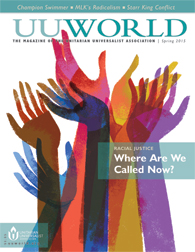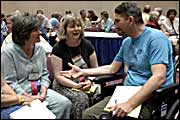Open Space process informs UUA goals
General Assembly experiments with new meeting process.
Moderator Gini Courter announced during the first business plenary that “this year 40 percent of plenary time has been cut, and other things changed in order to provide time and space for a three-day process of discussion and decision-making concerning what should be the mission of the UUA.” Courter invited all GA attendees, not just delegates, to participate in the “Open Space Technology” process.
It didn’t take long for confusion to set in. Many people expressed uncertainty about the purpose of Open Space as well as the process.
“I heard people ask, ‘Are we voting on a new mission statement?’” said Helen Bishop, coordinator of the Open Space process, in a phone interview. “The answer is absolutely not. What we are doing is telling the board what people think is important; what issues they should be paying attention to.”
Despite the confusion, the first Open Space session attracted approximately one-fifth of GA attendees.
On Thursday morning, participants were divided into ten large concurrent groups to create a list of issues they thought the Association should be focusing on. That afternoon and continuing into the next day the resulting 117 topics were discussed in short breakout sessions, with attendance ranging from one or two to twenty people per topic. On Saturday participants were asked to rejoin their original large groups to consider the breakout session results and compile a series of brief statements that answered the question posed by the Board of Trustees: “In today’s complex world, what is our mission as a faith community?” The resulting thirty statements ranged from “To imagine and realize a just global earth community of all beings” to “Covenant to deepen our spiritual practice, explicitly connecting our faith with action.”
Developed in the late ’80s, Open Space operates under four basic principles: Whoever comes is the right group of people; whenever it starts is the right time; whatever happens is the only thing that could have; and when it’s over, it’s over.
Easier said than done. For some Unitarian Universalists, who hold meetings with as much reverence as they hold worship (or more), this free-form organizational process felt akin to sacrilege. But for others it was a refreshing opportunity to participate and feel heard.
Munro Sickafoose of First Unitarian Church in Portland, Oregon, at his first GA, attended sessions throughout the three-day process. “I’m one of those people who likes to get involved in processes and ideas and input,” he said. “I think what I sensed was a real need from a lot of the participants who either weren’t delegates or maybe feel sort of removed from the processes of decision making to put their two cents into the process and be involved.”
Bishop said that 1,100 people participated in the opening sessions, around 830 participated in the 117 formal breakout sessions, and around 390 people attended the convergence sessions that produced the final thirty statements. These numbers do not distinguish between repeat attendees.
Throughout the process, trends emerged that pointed to participants’ shared priorities. Popular topics dealt with retaining youth, withdrawing from Iraq, antiracism/antioppression work, church growth, right relations, and the environment.
The Rev. Nadine Swahnberg of the Jefferson Unitarian Church in Golden, Colorado, found the breakout sessions a mixed success. Disappointed with the first group she attended, she switched to another session and said it was like “a different world. I was deeply moved by what the people were contributing.” She said the juxtaposition of the two made her aware of how powerful the process can be when it’s working.
So why didn’t more people attend Open Space sessions? Many wanted to attend other workshops or meetings. Others either didn’t understand the point or simply didn’t feel like participating.
First-time GA-goers Lezlie and Matt McDaniel of the Skagit UU Fellowship in Mount Vernon, Washington, were among those who chose not to participate. “I thought it was just for delegates,” said Lezlie, demonstrating the kind of confusion that continued to plague the process throughout the week. As for Matt, he just had different priorities. “Some of us come to General Assembly to listen and learn,” he said. “Open Space sounded like work. I didn’t come here for that.”
Delegates voted on the thirty final statements during Sunday morning’s plenary. The three clear leaders were “Support, integrate, and retain youth and young adults to keep our congregations vibrant and growing” (12.4 percent); “Build and grow antioppressive/antiracist faith community that embraces and is accountable to marginalized people” (10 percent); and “To move from domination to a new paradigm of partnership and sustainable Earth community” (6.8 percent). Another environmental statement received 5.9 percent.
Bishop said Open Space will likely be used again at the 2008 GA in Ft. Lauderdale. She said she hopes to do some retooling, using smaller rooms for later sessions and avoiding scheduling conflicts with major speakers, business meetings, and events.
See sidebar for links to related resources.








